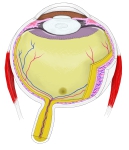



1) 暗所/明所 : 暗所ではその径は大きく(散瞳:~8.0mm)、明所では疎の径は小さい(縮瞳:~1.0mm)
※数字は「船戸和也のHP」を参照
2) 入射光の強さ : 入射光が強い場合は径は小さく、弱い場合は径が大きい。
3) 見えるものまでの距離 : 近くのものを見るときは瞳孔は小さくなる。
※「Wikipedia」では加齢による瞳孔の径の変化の解説も見られる。詳しくは下の英文の解説を参照のこと。

・「虹彩筋はすべて色素上皮細胞より分化する神経外胚葉由来の筋上皮組織である。」(船戸和也のHP)


|
|
|
 |
| 虹彩・瞳孔(前面) |
眼球・断面-1 |
眼球・断面-2 |
眼球・横断面-1 |

以下は「Wikipedia」の解説文となる。
The pupil is a black hole located in the center of the iris of the eye that allows light to strike the retina. It appears black because light rays entering the pupil are either absorbed by the tissues inside the eye directly, or absorbed after diffuse reflections within the eye that mostly miss exiting the narrow pupil. The term "pupil" was coined by Gerard of Cremona.
In humans, the pupil is round, but its shape varies between species; some cats, reptiles, and foxes have vertical slit pupils, goats have horizontally oriented pupils, and some catfish have annular types. In optical terms, the anatomical pupil is the eye's aperture and the iris is the aperture stop. The image of the pupil as seen from outside the eye is the entrance pupil, which does not exactly correspond to the location and size of the physical pupil because it is magnified by the cornea. On the inner edge lies a prominent structure, the collarette, marking the junction of the embryonic pupillary membrane covering the embryonic pupil.
【 語 句 】
・iris:虹彩 ・retina:網膜 ・diffuse reflection:拡散反射 ・coin:作り出す ・catfish:ナマズ ・aperture:穴 ・entrance pupil:入射ひとみ? ・magnify:拡大する ・cornea:角膜 ・collarette:捲縮輪 ・embryonic:胎生の、未発達の
【Structure】
The pupil is a hole located in the center of the iris of the eye that allows light to strike the retina. It appears black because light rays entering the pupil are either absorbed by the tissues inside the eye directly, or absorbed after diffuse reflections within the eye that mostly miss exiting the narrow pupil.
【Function】
See also: Iris (anatomy)
The iris is a contractile structure, consisting mainly of smooth muscle, surrounding the pupil. Light enters the eye through the pupil, and the iris regulates the amount of light by controlling the size of the pupil. This is known as the pupillary light reflex.
The iris contains two groups of smooth muscles; a circular group called the sphincter pupillae, and a radial group called the dilator pupillae. When the sphincter pupillae contract, the iris decreases or constricts the size of the pupil. The dilator pupillae, innervated by sympathetic nerves from the superior cervical ganglion, cause the pupil to dilate when they contract. These muscles are sometimes referred to as intrinsic eye muscles.
The sensory pathway (rod or cone, bipolar, ganglion) is linked with its counterpart in the other eye by a partial crossover of each eye's fibers. This causes the effect in one eye to carry over to the other.
【 語 句 】
・contractile:収縮を起こす ・smooth muscle:平滑筋 ・pupillary light reflex:瞳孔対光反応 ・sphincter pupillae:瞳孔括約筋 ・dilator pupillae:瞳孔散大筋 ・constrict:収縮させる ・sympathetic nerves:交感神経 ・superior cervical ganglion:上頚神経節 ・intrinsic eye muscles:内眼筋 ・sensory pathway:感覚系伝導路 ・counterpart:よく似たもの ・carry over:持ち越す
Effect of light
The pupil gets wider in the dark and narrower in light. When narrow, the diameter is 2 to 4 millimeters. In the dark it will be the same at first, but will approach the maximum distance for a wide pupil 3 to 8 mm. However, in any human age group there is considerable variation in maximal pupil size. For example, at the peak age of 15, the dark-adapted pupil can vary from 4 mm to 9 mm with different individuals. After 25 years of age, the average pupil size decreases, though not at a steady rate. At this stage the pupils do not remain completely still, therefore may lead to oscillation, which may intensify and become known as hippus. The constriction of the pupil and near vision are closely tied. In bright light, the pupils constrict to prevent aberrations of light rays and thus attain their expected acuity; in the dark, this is not necessary, so it is chiefly concerned with admitting sufficient light into the eye.
When bright light is shone on the eye,
light-sensitive cells in the retina, including rod and cone photoreceptors and
melanopsin ganglion cells, will send signals to the
oculomotor nerve, specifically the
parasympathetic part coming from the
Edinger-Westphal nucleus, which terminates on the circular iris sphincter muscle. When this muscle contracts, it reduces the size of the pupil. This is the
pupillary light reflex, which is an important test of
brainstem function. Furthermore, the pupil will dilate if a person sees an object of interest
【 語 句 】
・oscillation:変動、振幅 ・intensify:強める ・hippus:瞳孔動揺 ・aberration:正道をはずれること ・attain:成し遂げる ・acuity:鋭敏さ ・light-sensitive cell:視細胞? ・melanospis:メラノプシン(光感受性の細胞内色素タンパク質) ・oculomotor nerve: ・parasympathetic: ・Edinger-Westphal nucleus:エディンガー・ウェストファル核 ・: ・: ・: ・: ・: ・: ・: ・: ・: ・: ・: ・: ・: ・: ・: ・: ・: ・: ・: ・: ・: ・: ・: ・: ・:
■ 写真やイラストを掲載しているサイト ■
・ イラストや写真を掲載しているサイト-Ⅰ
・ イラストや写真を掲載しているサイト-Ⅱ
・ イラストや写真を掲載しているサイト-Ⅲ
・ イラストや写真を掲載しているサイト-Ⅳ
・ イラストや写真を掲載しているサイト-Ⅴ
